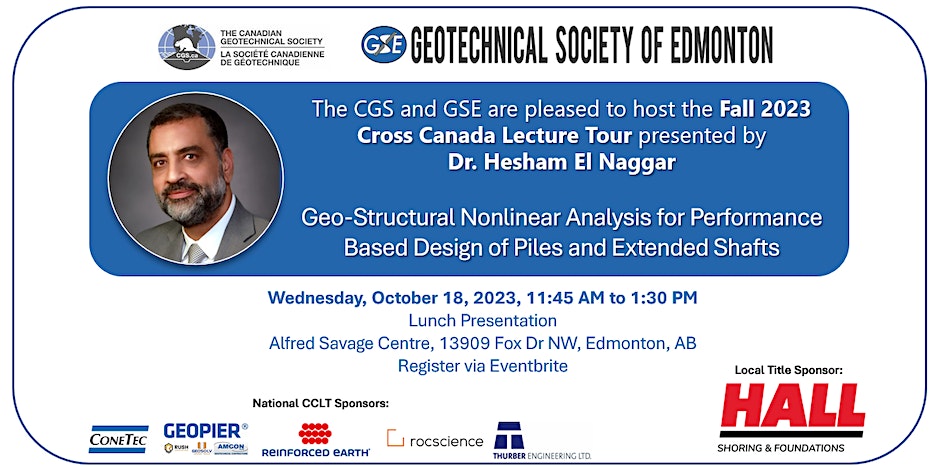The Geotechnical Society of Edmonton is pleased to present the Canadian Geotechnical Society Cross-Canada Lecture Tour featuring Dr. Hesham El Naggar.
Date: October 18, 2023
Time: 11:30am – 1:30pm
Location: Alfred H. Savage Centre, 13909 Fox Drive NW
Cost: GSE/CGS Members $30, Students $15, Non-members $40
Click to register for in-person attendance on EventBrite
Abstract
Pile foundations are utilized to support a variety of important infrastructure where they are subjected to static and/or dynamic lateral loads due to lateral earth pressure, vessel impacts, traffic, waves, wind, and earthquakes. The pile lateral behavior under extreme lateral loading is governed by two main factors: the interaction between the pile and surrounding soil, and the material inelasticity of the soil and pile itself. This presentation covers the state-of-the-art of modelling the nonlinear response of piles. It describes the recent development of an efficient and robust approach for the analysis of piles based on the Beam on Nonlinear Winkler (BNWF). In this work, a general cyclic BNWF model is developed to account for the important features of soil-pile interaction problem including lateral load characteristics, soil cave-in, soil-pile side shear, gap formation, and strength and stiffness hardening/degradation. The inelastic behavior of pile material is also modelled effectively by implementing the advanced fiber technique. The capability of the developed model in predicting the response of piles under lateral static, cyclic and seismic loading is validated by comparing the computed results with experimental data.
Extended pile-shafts are commonly used as cost-effective foundation for highway bridges in which piles extend above ground level as columns to support the bridge. Seismic design of bridges is effectively accomplished employing the performance-based design (PBD) approach. Seismic lateral force would lead to inevitable development of plastic hinge along the pile below ground surface, which also facilitates the bridge ductile performance. Equivalent fixed-base cantilever model is used in industry to analyze the pile response. Equations are developed for evaluating depth-to-fixity, location and length of plastic hinge, pile lateral capacity and ultimate bending moment that are required for this simplified design approach.
Bio
Dr. Hesham El Naggar is a Distinguished University professor and a world leader in foundation dynamics and geotechnical earthquake engineering. He advanced the state-of-the-art in analysis and design of foundations for dynamic loads. His innovative work on foundation dynamics led to the development of DYNA6, the industry-standard in machine foundation design. His work on foundation design and geotechnical earthquake engineering has been incorporated into design guidelines recommended by regulatory bodies and learned societies. He is Editor-In-Chief of Soil Dynamics and Earthquake Engineering and past Associate Editor of the Canadian Geotechnical Journal. He published more than 550 technical papers and book chapters including 400 in selective and prestigious journals on foundations, soil-structure interaction and geotechnical earthquake engineering; and consulted on major projects worldwide. He has delivered more than 50 plenary, keynotes and invited speeches at national and international conferences. Dr. El Naggar attracted more than $20M of research funding and graduated more than 120 PhD and Master students. In recognition of his outstanding research contributions, Dr. El Naggar received many prestigious awards including the Geosynthetics, Stermac, Meyerhof and Canadian Geotechnical Colloquium Speaker Awards from the Canadian Geotechnical Society; the Ontario Professional Engineers Medal for Engineering Research & Development; the prestigious 2021 Zhongguancun Award for Outstanding Contribution, from Beijing Council of Science and Technology; the Faculty Scholar Award, Outstanding Teaching, Research Excellence and Distinguished University Professor Awards from Western University. He is an elected Fellow of Canadian Academy of Engineering, the Engineering Institute of Canada and the American Society for Civil Engineers.

